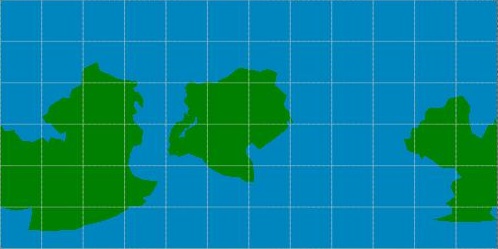Over the past 2 weeks, I've been attempting to create a planet with a plausible continental drift. I was really hoping to get some kind of response to my work.
I'll stick up my hand and admit it right now - I am no expert on this matter. I've done a fair amount of research, but I have gaping holes in the field of geology.
One other thing, I apologise beforehand if this isn't the typical thing that is present on WSE. I've only seen questions posted here before, but I just thought I'd try my luck.
Anyway, without further ado, let's begin
900 MYA
Supercontinent, comparatively recent formation. Gradually drifting northwest.
800 MYA
Supercontinent continued, rift soon to form in the east.
700 MYA
Supercontinent has rifted, a larger portion in the west, a smaller portion to the east, hereafter referred to as Supercontinent A and Supercontinent B, respectively.
600 MYA
A narrow portion of land on the other side of Supercontinent A has rifted away, and what is left is about to rift in half very soon.
500 MYA
Supercontinent A has split entirely. The first portion to rift is moving north at a remarkably fast pace, and the remainder has split into a continent over the south pole, and a continent on the equator.
Supercontinent B has remained relatively stable, but this is not to last.
400 MYA
Supercontinent A's remnant on the equator moves northeast, and begins subduct the ocean to its eastern side, eventually including the rift of the original supercontinent
Supercontinent B rifts, and its western portion begins to be affected by the subduction, drifting westwards.
The continent over the south pole has also split in two, its more northerly portion set to collide with the continents upon the equator. Similar to the above-mentioned continent, it begins to subduct the rift present.
The narrow continent has split, one half on the equator, the other half having drifted farther north. Due to the subduction of the oceanic rift, however, the continent begins to drift back south.
300 MYA
Another supercontinent is due to form.
Supercontinent A's equator remnant has split, one half due to remain an isolated continent, for now.
200 MYA
A new supercontinent has formed, drifting north and rotating counter-clockwise. The isolated continent is drifting over the north pole, and a collision is due in several million years.
100 MYA
Isolated continent has collided, but the supercontinent itself is beginning to break up. A small island continent has split off.
Present
Supercontinent has split, two continents to the south, with a large island, and three continents to the north, one over the north pole.
EDIT - in response to an inquiry, a few details about the world itself, at least those that I've already figured out -
- Planet age - ~8.4B years
- Distance from star - ~3/4 Earth distance
So, yeah. Would love any responses. What is plausible, or not. If this is too open-ended, or opinion-based, I'll be perfectly happy to have this question closed. But yeah, responses are appreciated.










